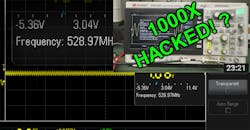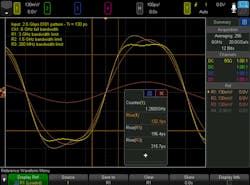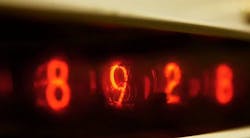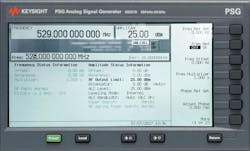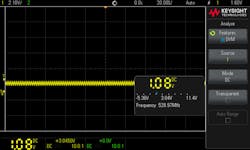Hacking the Specs: Frequency Counter on an Oscilloscope
Download this article in PDF format.
Everyone loves a bargain. Who doesn’t love a hacked oscilloscope? Well, it would be unusual for an oscilloscope company to teach you how to hack your own hardware. Besides, that’s already been done (Fig. 1). So, I’m coining a new term: “spec hack.”
1. Just a few days after its release, the EEVBlog YouTube channel posted an oscilloscope hack to double the bandwidth of the 1000 X-Series.
Webster’s dictionary will someday define it as such:
Spec hack (/spek’hak/), n. When an engineer uses a clever and advanced knowledge of their equipment to achieve equipment performance above and beyond typical expectations of said equipment.So, today we will go on a quest to see what sort of spec hack we can muster with your oscilloscope’s built-in frequency counter.
You might think that a 100-MHz oscilloscope will only let you see signals up to 100 MHz, but that’s simply not true. Why? Because oscilloscope bandwidth isn’t as straightforward as the spec on the label.
First, some background. An oscilloscope isn’t just an oscilloscope anymore. Ever since HP’s invention of the MSO back in 1996, oscilloscopes like the Keysight InfiniiVision 1000 X-Series low-cost oscilloscope have been integrating more and more test and measurement equipment into one box. In recent years, one of those additions is a built-in hardware frequency counter. Also—shameless plug—you get it for free when you register your Keysight InfiniiVision Oscilloscope.
Oscilloscope Bandwidth Brush-Up
To fully understand how far you can push your frequency counter, you must first understand how your oscilloscope’s bandwidth works. If you feel confident that you know the ins and outs of bandwidth, feel free to skip down to the “How a Frequency Counter Works” section. If not, get ready to have your mind blown (or at least learn a little something).
Bandwidth
Basically, if you have an oscilloscope with a 100-MHz bandwidth, it means you can see a sine wave (or frequency components of a non-sine wave) of 100 MHz with less than or equal to 3 dB of attenuation. So, a 1-V, 100-MHz sine wave input would appear on your oscilloscope screen as a 707-mV, 100-MHz sine wave. I know, it’s crazy that you can have a signal appear 30% lower on screen and it be normal, but that’s why you should give yourself some headroom with your bandwidth—especially if you’re working with digital signals. Remember, a square wave is a combination of higher frequency harmonics.
Here’s the thing to remember: Bandwidth is all about signal attenuation, not just about what frequencies you can or can’t see (Fig. 2). So, you can see signals that are higher than the bandwidth of your oscilloscope; they’ll just appear smaller.
2. A Keysight 6000 X-Series Oscilloscope demonstrates what a 2.5-Gb/s waveform looks like at varying bandwidths. Even at 200 MHz, there’s still a visible signal, but it’s not an accurate representation of the real-world signal.
Usually this doesn’t make a difference for your day-to-day oscilloscope usage. You may see rounded corners on what should be a sharp square wave, but it probably won’t change your engineering decisions. However, when you’re using a built-in frequency counter, you can take advantage of this effect.
How a Frequency Counter Works
To understand how you can use bandwidth attenuation to your advantage, you should understand how a frequency counter works. It’s called a frequency counter because it literally counts. It counts the number of edges it sees in a specified amount of time, called the gate time. The frequency is then calculated like this:
Frequency = Number of pulses/Gate time
From a hardware perspective, the counter is essentially just a comparator (to identify signal edges) and a microcontroller to count the output and display the results (Fig. 3). As luck would have it, oscilloscopes already have this infrastructure built into their trigger systems.
3. A vintage HP frequency counter’s nixie tube display.
Why Oscilloscopes Make Great Counters
As it turns out, the trigger circuitry of an oscilloscope often has comparators built into the signal path (for edge triggers and more). So, with the right planning, it’s not too difficult for oscilloscope designers to build a frequency counter into the oscilloscope. It may require some extra hardware, but the essentials are already built in.
The most important spec of a frequency counter is accuracy. The higher the precision of the time base, the more accurate the counter. Oscilloscopes must have a highly accurate time base, so a built-in counter can just leverage the oscilloscope’s clock.
Finally, the trigger circuitry of an oscilloscope often has its own special signal path designed to extract the core signal and ignore noise and other components. Unlike the oscilloscope’s acquisition circuitry, the trigger circuitry doesn’t need to recreate the signal with high accuracy. It only needs to do a fantastic job of finding edges. So, a frequency counter can simply use the oscilloscope’s trigger signal path instead of the acquisition signal path and get a higher fidelity edge.
The Spec Hack
So, let’s put it all together. We’ve learned a few things:
- You can see signals (or signal edges) higher than the bandwidth of your oscilloscope, but it may have an attenuated amplitude.
- Frequency counters simply need to count edges; they don’t care very much about the amplitude of the signal.
- An oscilloscope has a specially conditioned signal path dedicated to identifying edges.
So, a frequency counter built into an oscilloscope can theoretically measure frequencies higher than the bandwidth of the oscilloscope. The question is, how much higher?
One of the perks of working at Keysight is that it isn’t hard to answer that question. I pulled out my 100-MHz Keysight 1000 X-Series low-cost oscilloscope and a comedically unnecessary Keysight 67-GHz PSG (because why not) (Fig. 4), and ran a frequency sweep to see how high of a frequency could be measured by the oscilloscope’s frequency counter.
4. A 529-MHz sine wave being produced by a PSG.
The results blew me away!
The 100-MHz oscilloscope’s counter could measure up to 529 MHz! That’s over 5X the bandwidth of the oscilloscope (Fig. 5).
5. A screenshot of the frequency counter measuring 529 MHz.
Get Bonus Accuracy
One of the most important specifications of a frequency counter is its time-base accuracy.
In the case of an oscilloscope with an integrated frequency counter, the counter’s specs typically match the oscilloscope’s specs. But, with some scopes, you can use an external 10-MHz reference and improve the oscilloscope time-base accuracy to the accuracy of your 10-MHz source. If you increase the accuracy of your oscilloscope, you’re increasing the accuracy of the built-in counter as well.
The Takeaway? Know Your Gear!
It’s always fun to find a hidden gem in your test equipment. Sometimes it’s an Easter egg mini game tucked away in a secret menu; sometimes it’s a measurement you didn’t know you could make. Having a solid understanding of the fundamentals behind your equipment will not only help you make better, more accurate measurements, but also help you avoid traps that could lead you down the wrong debugging path.
Are there any spec hacks that you have found? Be sure to let me know in the comments below or on Twitter (@Keysight_Daniel). Happy testing!
About the Author

Daniel Bogdanoff
Oscilloscope Product Manager
Daniel Bogdanoff is the Product Manager for the InfiniiVision series of oscilloscopes at Keysight Technologies. He graduated from Texas A&M with a degree in electrical engineering. In his spare time, Daniel enjoys whitewater kayaking, mountain biking and playing various musical instruments.
